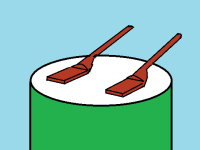The positive nipple of an 18650 / 21700 is very robust and can be reliably spot-welded or even soldered. However, the negative end is sensitive to heat. I know that billions of cells have been spot-welded by industry, but of course they are done by very expensive machines that provide very precise and repeatable results, which is suspect are teetering on the brink of being very bad for the insides of the cell.
I mention this because there has been a boom of DIY battery pack builders, using "pocket" spot-welders (kWeld, Malectrics, JP, Boss level, Aukashiria, etc)...And LFP has been very helpful in pointing out danger zones that are at risk from a bad spot-weld.
The main culprit is heat. Nickel melts at roughly 2600F, and 63/37-solder melts at roughly 361F. However, a spot-weld is accomplished in milliseconds, and soldering (using best practices) can take up to 3 seconds. The thought occurred to me that soldering a fuse-wire would cause even less heat to penetrate into the cell. I propose calculating the cross-section of copper wire needed, and dividing it in half because there is a benefit to using two wires per cell.
I also think there is a benefit to flattening the tips of the two wires that are to be soldered onto the negative ends of the cell. Flattened tips would have a very thin amount of solder in order to make a good bond with the minimum possible amount of resistance during operation.
Tin the wire-tips with solder ahead of time, and then add flux to a recently-cleaned negative cell end. Press down with some type of probe to maintain pressure during the entire operation, then touch a 100W soldering iron to the wire-tip for the minimum amount of time. A simple tug on the wire should tell if a good bond has been made, but if it pulls off, then there wasn't enough heat, so the cell should not have been damaged.
Because the negative outlet of the jelly-roll is bonded to the center of the inside of the negative end of the can...I've seen several references in instructional manuals to never spot-weld to the center of the outside of the can (presumably, too much heat can damage or loosen the internal connection.

I believe that the damage done by soldering 8mm wide nickel strips to the negative ends of 18650's is because there is so much total heat that needs to be applied, the center gets hot, and the soldering iron has to be held onto the assembly for so long. I am hopeful that this proposal may turn out to be an improvement. This is because so many pack builders continue to use soldering, which I am reluctant to recommend.
I mention this because there has been a boom of DIY battery pack builders, using "pocket" spot-welders (kWeld, Malectrics, JP, Boss level, Aukashiria, etc)...And LFP has been very helpful in pointing out danger zones that are at risk from a bad spot-weld.
The main culprit is heat. Nickel melts at roughly 2600F, and 63/37-solder melts at roughly 361F. However, a spot-weld is accomplished in milliseconds, and soldering (using best practices) can take up to 3 seconds. The thought occurred to me that soldering a fuse-wire would cause even less heat to penetrate into the cell. I propose calculating the cross-section of copper wire needed, and dividing it in half because there is a benefit to using two wires per cell.
I also think there is a benefit to flattening the tips of the two wires that are to be soldered onto the negative ends of the cell. Flattened tips would have a very thin amount of solder in order to make a good bond with the minimum possible amount of resistance during operation.
Tin the wire-tips with solder ahead of time, and then add flux to a recently-cleaned negative cell end. Press down with some type of probe to maintain pressure during the entire operation, then touch a 100W soldering iron to the wire-tip for the minimum amount of time. A simple tug on the wire should tell if a good bond has been made, but if it pulls off, then there wasn't enough heat, so the cell should not have been damaged.
Because the negative outlet of the jelly-roll is bonded to the center of the inside of the negative end of the can...I've seen several references in instructional manuals to never spot-weld to the center of the outside of the can (presumably, too much heat can damage or loosen the internal connection.

I believe that the damage done by soldering 8mm wide nickel strips to the negative ends of 18650's is because there is so much total heat that needs to be applied, the center gets hot, and the soldering iron has to be held onto the assembly for so long. I am hopeful that this proposal may turn out to be an improvement. This is because so many pack builders continue to use soldering, which I am reluctant to recommend.

